Chronicle sverhtyazhelovesov space. Part 1. Lunar "dinosaurs"
 Bashny.Net
Bashny.Net

Man of old sought to outdo themselves. Using the inherent nature of the potential, we both feared and stretched to the entire grand. If our ancient ancestors aspired to become like gods by erecting huge monuments, then without a doubt, "Tower of Babel" of our time was the space age. It is best to truly cosmic ambitions of human genius express his ambitious technological projects. The following discussion focuses on the history of the creation of superheavy space transportation systems and the future prospects of their use.
In March '59, two years before the first manned flight into space, NASA conducted a test firing powerful at that time (and before the start of the 80th years) rocket motor F 1 offspring firm Rocketdyne.
This single chamber LRE weighing 9m, thrust and specific impulse 700t in 265s, has an important role in future lunar rocket Apollo program. Of the projects moon rocket Saturn with 2, 3 and 4, in the final version of the media constructed a team of Werner von Braun, a 62g configuration was chosen since 5 Engine F 1 - Saturn 5 or later Saturn 5.
Note: The specific impulse rocket engine expresses its effectiveness. As the ratio of the momentum generated (pulse) to the fuel consumption, it is translated into "human" language as the time (in seconds) during which the engine produces thrust in 1kg, consuming fuel of the same mass. The higher U.impuls, the more efficient the engine and fuel efficient. In the post, this value as traction, said to the sea level at the start and increases in average during the flight to 10-15%. I>
One of the fire test engine F 1 in 60g. Note the characteristic dark rocket jet. Features of the cooling system of the engine nozzle, when through a tube in his part of the structure of the fuel is pumped into the combustion chamber. I>

Setting the F 1 engines on the first stage of the Saturn rocket 5. The lower part of the nozzle was installed after the installation of the engine i>
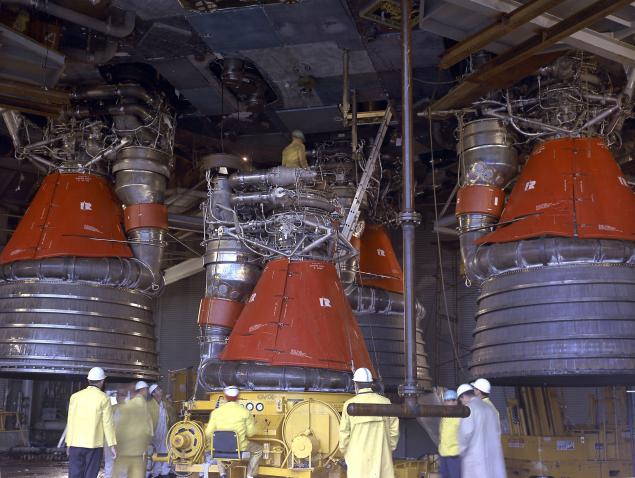
More than a year later, at the end of 63 years, and on the other side of the globe were tested Soviet LRE NC 15, the main engines of the first stage rival American media - the rocket H 1, the joint brainchild of Misha and the Queen. Because of the relatively small traction in 150T (with a weight of 1, 2m and momentum 297s), originally intended to place the motor 24 in the first stage of the rocket. By the end of the test the engine in 67g, their number was adjusted to 30, with an increase in payload rocket from 70 to 90t.
30 engines NK 15 in Block A RN H 1. I>
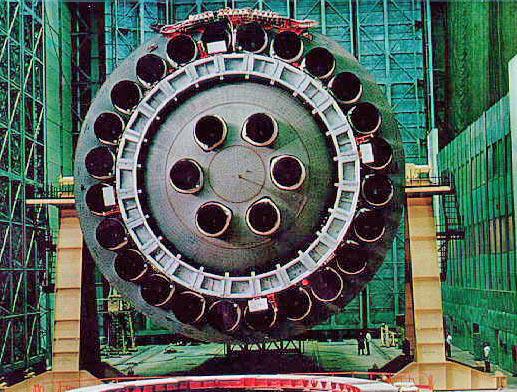
In November of the same year, the first Saturn 5 was already standing on the starting position of Cape Canaveral, Florida. Unmanned test mission Apollo 4 was launched on schedule on November 9, 1967 at 12 am at the world time. The first stage of the rocket engines S1C through 5 F 1 allows the missile to 110m in height and weighing nearly 3000t, starting to develop traction in 3500t!
«traditional» NASA vertical delivery and installation of the Saturn 5 rocket to the launch pad. Cape Canaveral, Florida. The scale is impressive i>

Step S1C weighed 2300t and consume 770,000 liters of kerosene WP1 and 1.3 million liters of oxygen for 150 -160 seconds, driving the rocket to 2, 3 km / s at a height of 68 km.
The second stage of the rocket - SII weighing 460t included 5 engines J2, providing a total thrust of 500 tons in vacuum (pulse 420 in a vacuum). For 6 minutes all 5 motors consume 70 tons of hydrogen and oxygen 360t until stage is not separated at an altitude of 186km, at a speed of 7 km / s.
The third stage SIVB (and concurrently the second stage carrier Saturn 1B), has one engine J2, whose stage refuel 73 tons of oxygen and hydrogen 16t.
Engine includes twice, first for final ascent stage into low orbit for 2, 5 minutes, and then to disperse to the moon. However, the program was limited to only 4 Apollo Apollo testing in Earth orbit. Payload rockets during the Apollo 15 mission totaled 140 tons in low Earth orbit (LEO).
The scheme rocket Saturn 5 i>
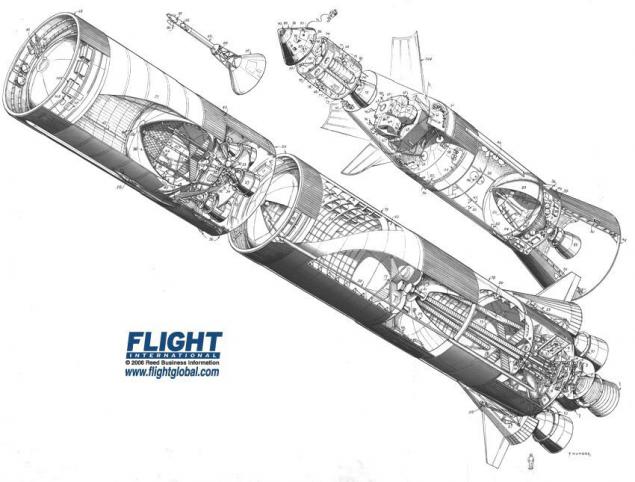
Running PH Saturn 5 i>
By the time the Soviet designers realized that late, for a test flight of the rocket H 1 was planned only to '69. To ensure the priority of the USSR in the moon race was decided to concentrate on a manned flight around the Moon on Zond program, using more then young offspring Chelomeya - "Proton". For the first manned flight around the moon within the American mission Apollo 8 in December '68, the moon had only two fly Soviet turtles.
The manned version of the Proton K with the lunar spacecraft 7K L1 ( circled the moon ). Manned options RN easily distinguished by the location on top of emergency rescue system. Note the 4 lattice stabilizer fairing RN, in the likeness of "Soyuz» i>
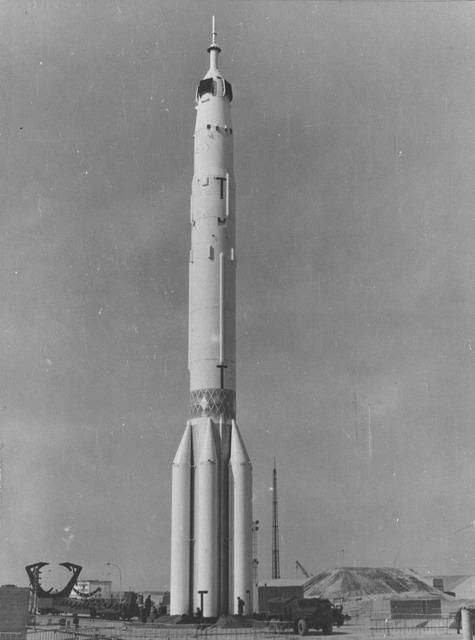
Exactly two months later, in February of '69, the first rocket H 1 is already preparing for the first flight at Baikonur. According to the plans, this colossus of 105m in height and weighing 2800t, was to deliver a payload that included a lunar expedition complex 7K-L1A / L1S weighing 90 tons, the Earth's orbit.
«Traditional" already for the Soviet space program delivery and installation of horizontal RN H 1 on the launch pad. Baikonur Cosmodrome i>
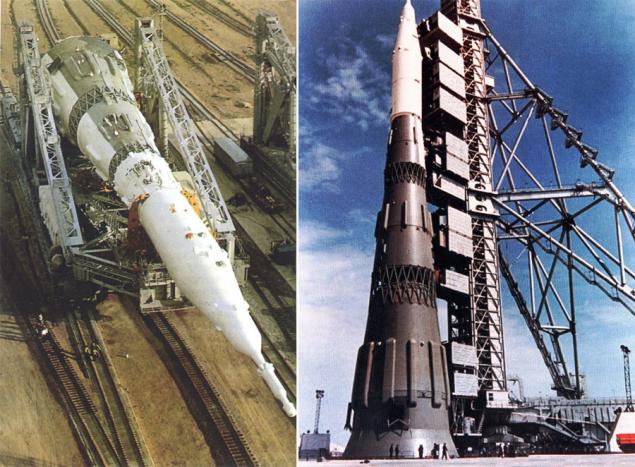
The first stage of "Block A", weighing 1880t and 30 armed oxygen / kerosene engines NK 15 of thrust when starting in 4600t, to full working out of fuel for 120 seconds.
3D animation RN H 1. It can be seen in flight nomination lattice stabilizers in the first stage i>

The second stage of "Block B", weighing 560t, clocked 8 engines NK 15B, developing a thrust of 1400t for 120 seconds. In view of the universality of the rocket H 1, "Block B" together with the third stage "Block B" and fourth "Block D", could be used as an independent RN H 11 is output to the DOE 20t payload.
"Block B", weighing 180 tons, and the total thrust of the engines x4 NC 31 to 170t, worked 6 minutes.
Also separately in conjunction with the fourth step "block D" could be used as PH H 111 with a payload of 5T.
The fourth stage is "Block D", and the fifth step "Block D" weighing 80 tons were used for final ascent expedition ship to Earth orbit and beyond on the flight path to the Moon.
flight simulation complex lunar rocket H 1 Orbiter i>
Comparison of the sizes of the two competitive RN and RN circuit H 1 i>

In practice, all four rocket launch alert. The second rocket launch H 1 produced a few weeks before the historic Apollo 11 mission in July 69goda, ended the destruction of both the missiles and the entire launch pad.
The fourth and last flight of the missile took place on November 25, 72, two weeks before the final, ninth manned lunar mission - Apollo 17. The explosion of one of the engines of the first stage in 7 seconds before its separation from the launch vehicle, led to the elimination of all media.
One of the main problems of the media believe that for such a complex system of 30 engines have selected too rough mining option - instead of bench tests, it was decided to bring the missile in flight. Reasons for choosing this method a few - this latest entry of the USSR in the race to the moon, as well as very poor funding of the project: 6 billion rubles for the entire lunar program of the USSR, against 6, $ 5 billion for the development of a Saturn 5 rocket (90kop / $ 1 on 60th course).
The fifth missile launch was scheduled for 74god. The new version of the missile - N1F, modified engine was completed the first stage of NC 15 NC 33 -h30 total thrust of the engines increased to a record 5,000 tons and a payload - up to 100k! However, the rocket was not to fly. Mishina replaced as chief designer of rocket technology - VP Glushko , closed all the work on the carrier in May 74goda. Two finished copies were destroyed, and only through the efforts of Kuznetsova, led the development of NC 15 and its modifications in the OKB 276, 150 engines NK 33 and 43 have been preserved to our days. His bureau once commissioned the development of engines for the H 1, of the refusal of the more experienced OKB 456 headed by VP Glushko.
Today engines NC 33 used on private American RN "Antares" and light version of "Soyuz" - 2-1v.
This is the only time in the history of the Soviet space program, when medium or heavy rocket to fly without motors of the first stage of 476 KB (now NPO "Energomash") headed by Glushko (on account of EDO RD 107/108 family of missiles R-7, RD 253 for RN "Proton" RD 170/171 for "Zenit" and "Energy»).
Career more successful opponent of H 1 - 5 of Saturn ended in 1973 after the launch of the first American space station Skylab (May 14). Production facilities were concentrated on the already approved program «Space Shuttle». Incidentally engines F 1 is probably just waiting for a second life in the face of модификации F 1B promising for extra heavy rocket for NASA.
However, "extinction" was a giant moon and the beginning of a new milestone in the history of space exploration. More on this in the next section.
Source: habrahabr.ru/post/229143/
Tags
See also
Roscosmos plans to build a residential prototype lunar base in the 2018-2020 biennium
On the microwaves into space and a little Matan
Oversize Chronicle. Space haulers
Subtle complexity of rocketry: Part 5.
Subtle complexity of rocketry, Part 4: More about the engines and tanks
Baikonur - 60 years
Tagged with "necessarily"
The aggressiveness of the teenagers. We fed the beast, Lord...
Mike moss: Salt, sugar and fat — how the food giants put us on the needle

















